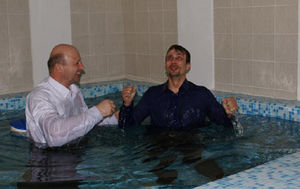History of Baptism

The Jewish Ritual of Baptism
Immersion in a ritual bath (Mikvah)is required for Ger tzedek (converts to Judaism) as part of their conversion. Other rituals for conversion to Judaism include circumcision and an understanding and observance of all the relevant laws. In the Tanakh, and other Jewish texts, bathing for ritual purification was established for specified circumstances; in order to be restored to a condition of 'ritual purity'. For example, Jews who become ritually 'defiled' by contact with a corpse (according to the Law of Moses), had to use the mikvah before being alowed to participate in the Holy Temple. Through practices such as these, immersion in the mikveh represent purification and restoration, and qualification for full religious participation in the life of the community. (See Book of Numbers Chapter 19) In modern times, the adherence and observance of the laws, rituals, and customs regarding the mikvah differ greatly among the Jewish denominations. The only modern exception is that after menses, women need to immerse in a mikvah in order to be permitted to her husband.
John the Baptist
John the Baptist, a prophet who preached before Jesus started teaching, foretold the soon coming of the Messiah. John was called the Baptist, as he and his disciples would baptise (immerse in water) those who believed his message of repentance for the remission of sins. Jesus himself was baptised by John the Baptist.
Historical evidence of baptism in the Early Christian Churches
All the histories agree that the Early Church baptised by immersion in the Name of the Lord Jesus Christ. This means that all of Jesus' disciples, the Apostle Paul, and even Mary (Jesus' mother) were baptised in the Name of the Lord Jesus Christ after the day of Pentecost. Encyclopedia Britannica:
Hastings Encyclopedia of Religion
Baptism in the Trinitarian Formula is not Biblical, and was added by men whose words are not included in the Holy Scriptures. Jesus said that the worship of the Pharisees was in vain because they were teaching for commandments the doctrines of men. The same can be said about anyone who baptises in the Trinitarian Formula.
A short analysis of Catholic, Orthodox, and Infant Baptism
Catholic Baptism The papacy says a sacrament must contain three elements to be valid:
The Catholic Church also says, with regards to baptism, that the correct intention is to do what the Church does as a matter of tradition. The tradition of the Catholic church is to baptise by aspersion (sprinkling water over the head) or affusion (pouring water over the head) in the name of the Father and of the Son and of the Holy Spirit. Orthodox Baptism The Orthodox Church teaches sprinkling or pouring in the name of the Father and of the Son and of the Holy Spirit. The Orthodox church also teaches that baptism should be preceded by fasting, and that, if cool running water is not available, the baptism should be done three times rather than once. (Didache, Chaper 7). Infant Baptism The Catholic, Orthodox, and Anglican Churches each baptize infants, while many Protestant churches do not baptize infants.
A short analysis of what the Scriptures teach about baptism
The Bible states that:
Furthermore, the Greek word for baptize (βάπτειν) means to fully immerse something in a fluid. Regarding Infant baptism, consider the scripture Repent and be baptised (Acts 2:38): If an infant is too young to repent (or understand repentance), how can they then be baptized? The Bible also says that Baptism is an act of good concience towards God. Infant baptism is an act of good concience by the parents of the infant on behalf of the infant, rather than a concious act of the infant. This is a simple matter of Tradition vs. Scripture. You have the choice of believing the Scriptures, or believing man-made tradition.
|